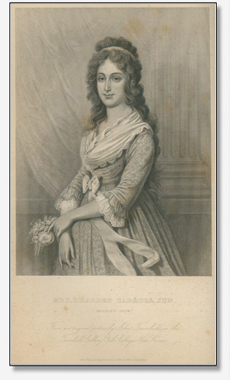
Rufus W. Griswold, The Republican Court, or, American Society in the Days of Washington. New and rev. ed. (New York, 1856), plate opposite 355. First ed., 1855.
HARRIET CHEW CARROLL (1775-1861) One of the nine children born to Benjamin Chew and his second wife Elizabeth Oswald, Harriet Chew grew up in two of the Philadelphia area’s finest mansions: the family’s elegant town house on South Third Street, Philadelphia, and Cliveden, their summer home in Germantown. Benjamin Chew was an esteemed lawyer, judge, and politician who worked closely with famous contemporaries such as John Adams, George Washington, and John Penn. It was for this reason that Harriet and her siblings were familiar with the members of the Republican Court. In fact, Harriet was supposedly a “great favorite” with Washington and sat with him while his portrait was being painted because the President claimed that “[her] conversation should give his face its most agreeable expression.”[1] Harriet Chew, as a member of the esteemed Chew family, was relatively well known in Philadelphia society, and attended Martha Washington’s first levee with her older sister Sophia. She further enhanced her public image by marrying Charles Carroll Jr. (1775-1825), the son of Charles Carroll of Carrolton, on July 17, 1800. Through her marriage, she established a relationship with Polly Carroll Caton, another favorite member of the Republican Court. With a wedding gift of $10,000 from his father, Carroll acquired a 130-acre farm just north of Baltimore, and began to build a large and luxurious home. The Carrolls named their house Homewood, and Charles Carroll Jr. became known as “Charles Carroll of Homewood.” He also became obsessed with making his estate as extravagant as possible, continually asking his father for contributions to cover the furniture, books, nurseries for his and Harriet’s six children, and more. Eventually, the expenses poured into Homewood totaled some $40,000—but this was not the end of Carroll of Homewood’s profligate ways.[2] Unfortunately for the couple, he became an alcoholic, and by 1814 their marriage was falling apart. With the approval of both her parents and her husband’s, Harriet and her children moved back to her father’s house in Philadelphia.[3] Harriet Chew Carroll died on April 8, 1861, survived by four daughters and one son. The Chew family mansion, Cliveden, was home to seven generations before being turned into a National Trust Historic Site; Homewood is now a house museum on the Johns Hopkins University campus in Baltimore. Written by Annie Turner. ______________________ [1] Rufus W. Griswold, The Republican Court, or, American Society in the Days of Washington (Boston: D. Appleton, 1885), 339, 315. [2] “American Notes: Baltimore Mansion, 1801-03, by Bennard B. Perlman,” Journal of the Society of Architectural Historians 14 (March 1955): 27. [3] “Tales from the Chew Family Papers: The Charity Castle Story,” Pennsylvania Magazine of History and Biography 132 (January 2008): 65-86. |

